Health Promotion Plan: A Comprehensive Approach to Patient Care
VerifiedAdded on 2022/08/11
|6
|1638
|21
Essay
AI Summary
This essay presents a health promotion plan for a patient suffering from both anxiety and type 2 diabetes. It outlines a comprehensive approach involving behavioral and medical interventions. The plan incorporates cognitive behavioral therapy, antidepressant medication, regular exercise, and a diet rich in omega-3 fatty acids to manage anxiety and improve overall health. The role of nurses in implementing the plan, including person-centered care and ethical considerations such as patient dignity and rights, is emphasized. The essay also highlights the importance of anti-diabetic drugs and diabetes awareness programs. The plan addresses lifestyle improvements, biomedical interventions, and socioeconomic support, ensuring a holistic approach to patient care and improved quality of life. The essay references various research studies and emphasizes the importance of effective communication between nurses and patients to build trust and encourage better health outcomes.
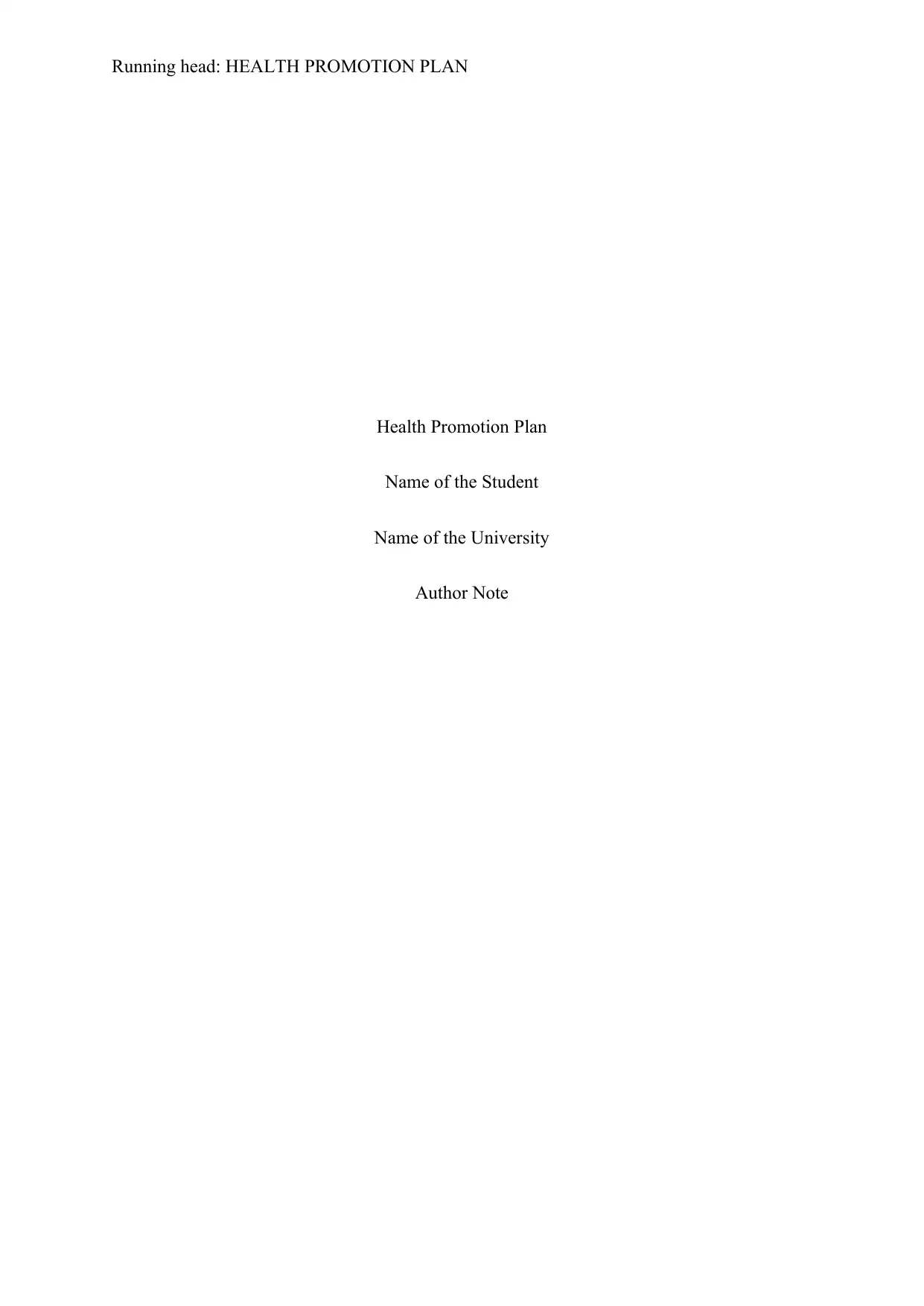
Running head: HEALTH PROMOTION PLAN
Health Promotion Plan
Name of the Student
Name of the University
Author Note
Health Promotion Plan
Name of the Student
Name of the University
Author Note
Paraphrase This Document
Need a fresh take? Get an instant paraphrase of this document with our AI Paraphraser
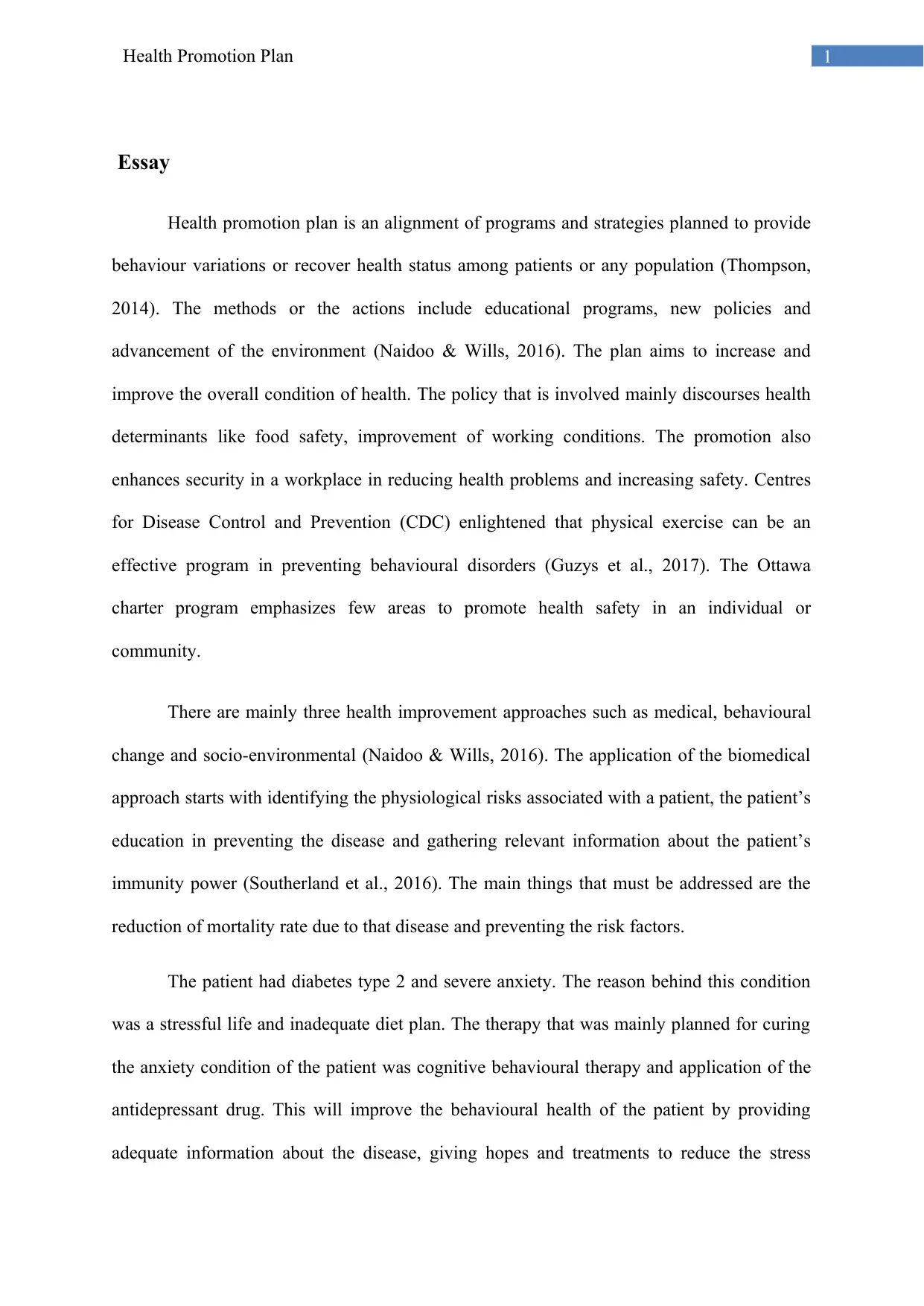
1Health Promotion Plan
Essay
Health promotion plan is an alignment of programs and strategies planned to provide
behaviour variations or recover health status among patients or any population (Thompson,
2014). The methods or the actions include educational programs, new policies and
advancement of the environment (Naidoo & Wills, 2016). The plan aims to increase and
improve the overall condition of health. The policy that is involved mainly discourses health
determinants like food safety, improvement of working conditions. The promotion also
enhances security in a workplace in reducing health problems and increasing safety. Centres
for Disease Control and Prevention (CDC) enlightened that physical exercise can be an
effective program in preventing behavioural disorders (Guzys et al., 2017). The Ottawa
charter program emphasizes few areas to promote health safety in an individual or
community.
There are mainly three health improvement approaches such as medical, behavioural
change and socio-environmental (Naidoo & Wills, 2016). The application of the biomedical
approach starts with identifying the physiological risks associated with a patient, the patient’s
education in preventing the disease and gathering relevant information about the patient’s
immunity power (Southerland et al., 2016). The main things that must be addressed are the
reduction of mortality rate due to that disease and preventing the risk factors.
The patient had diabetes type 2 and severe anxiety. The reason behind this condition
was a stressful life and inadequate diet plan. The therapy that was mainly planned for curing
the anxiety condition of the patient was cognitive behavioural therapy and application of the
antidepressant drug. This will improve the behavioural health of the patient by providing
adequate information about the disease, giving hopes and treatments to reduce the stress
Essay
Health promotion plan is an alignment of programs and strategies planned to provide
behaviour variations or recover health status among patients or any population (Thompson,
2014). The methods or the actions include educational programs, new policies and
advancement of the environment (Naidoo & Wills, 2016). The plan aims to increase and
improve the overall condition of health. The policy that is involved mainly discourses health
determinants like food safety, improvement of working conditions. The promotion also
enhances security in a workplace in reducing health problems and increasing safety. Centres
for Disease Control and Prevention (CDC) enlightened that physical exercise can be an
effective program in preventing behavioural disorders (Guzys et al., 2017). The Ottawa
charter program emphasizes few areas to promote health safety in an individual or
community.
There are mainly three health improvement approaches such as medical, behavioural
change and socio-environmental (Naidoo & Wills, 2016). The application of the biomedical
approach starts with identifying the physiological risks associated with a patient, the patient’s
education in preventing the disease and gathering relevant information about the patient’s
immunity power (Southerland et al., 2016). The main things that must be addressed are the
reduction of mortality rate due to that disease and preventing the risk factors.
The patient had diabetes type 2 and severe anxiety. The reason behind this condition
was a stressful life and inadequate diet plan. The therapy that was mainly planned for curing
the anxiety condition of the patient was cognitive behavioural therapy and application of the
antidepressant drug. This will improve the behavioural health of the patient by providing
adequate information about the disease, giving hopes and treatments to reduce the stress
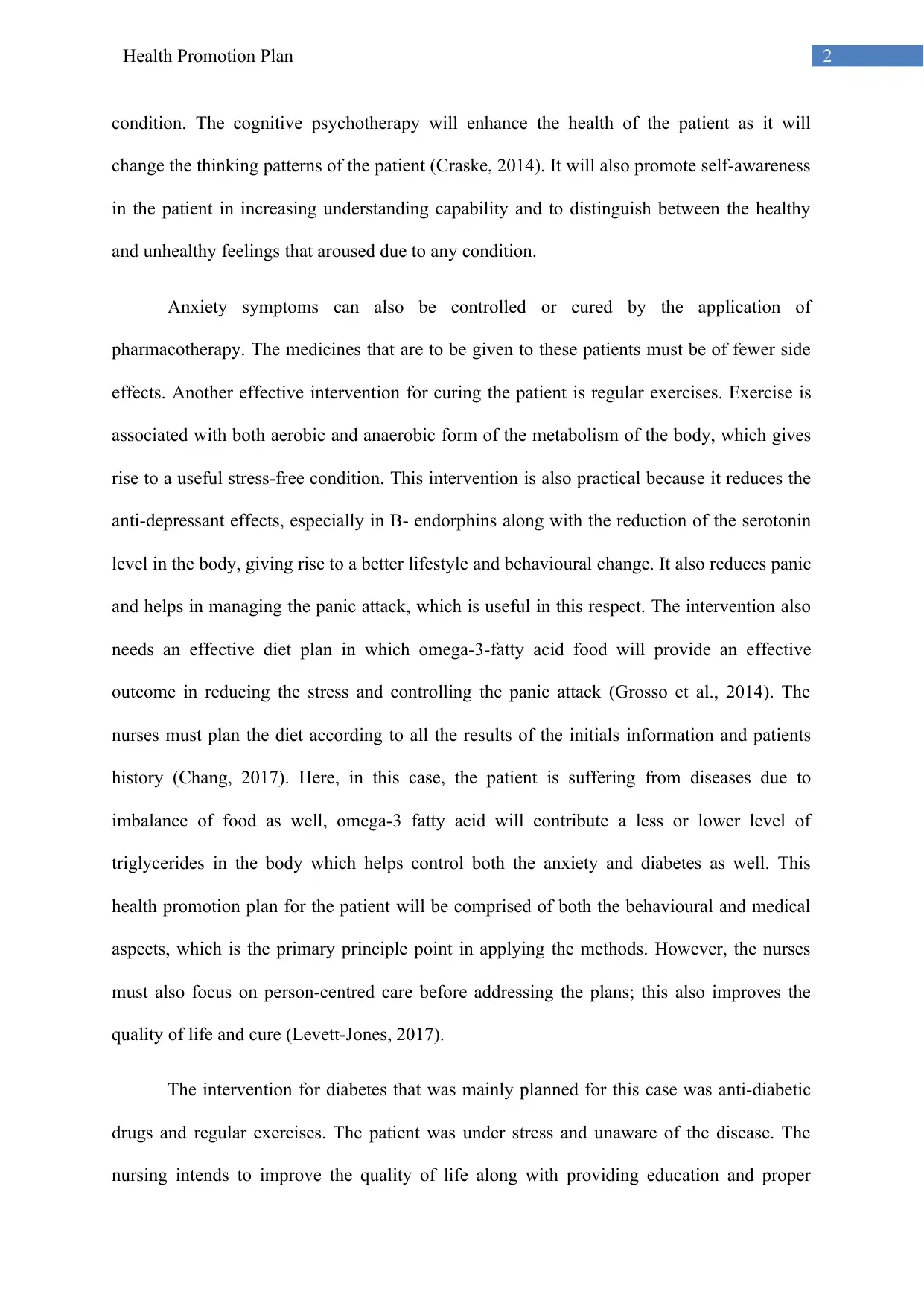
2Health Promotion Plan
condition. The cognitive psychotherapy will enhance the health of the patient as it will
change the thinking patterns of the patient (Craske, 2014). It will also promote self-awareness
in the patient in increasing understanding capability and to distinguish between the healthy
and unhealthy feelings that aroused due to any condition.
Anxiety symptoms can also be controlled or cured by the application of
pharmacotherapy. The medicines that are to be given to these patients must be of fewer side
effects. Another effective intervention for curing the patient is regular exercises. Exercise is
associated with both aerobic and anaerobic form of the metabolism of the body, which gives
rise to a useful stress-free condition. This intervention is also practical because it reduces the
anti-depressant effects, especially in B- endorphins along with the reduction of the serotonin
level in the body, giving rise to a better lifestyle and behavioural change. It also reduces panic
and helps in managing the panic attack, which is useful in this respect. The intervention also
needs an effective diet plan in which omega-3-fatty acid food will provide an effective
outcome in reducing the stress and controlling the panic attack (Grosso et al., 2014). The
nurses must plan the diet according to all the results of the initials information and patients
history (Chang, 2017). Here, in this case, the patient is suffering from diseases due to
imbalance of food as well, omega-3 fatty acid will contribute a less or lower level of
triglycerides in the body which helps control both the anxiety and diabetes as well. This
health promotion plan for the patient will be comprised of both the behavioural and medical
aspects, which is the primary principle point in applying the methods. However, the nurses
must also focus on person-centred care before addressing the plans; this also improves the
quality of life and cure (Levett-Jones, 2017).
The intervention for diabetes that was mainly planned for this case was anti-diabetic
drugs and regular exercises. The patient was under stress and unaware of the disease. The
nursing intends to improve the quality of life along with providing education and proper
condition. The cognitive psychotherapy will enhance the health of the patient as it will
change the thinking patterns of the patient (Craske, 2014). It will also promote self-awareness
in the patient in increasing understanding capability and to distinguish between the healthy
and unhealthy feelings that aroused due to any condition.
Anxiety symptoms can also be controlled or cured by the application of
pharmacotherapy. The medicines that are to be given to these patients must be of fewer side
effects. Another effective intervention for curing the patient is regular exercises. Exercise is
associated with both aerobic and anaerobic form of the metabolism of the body, which gives
rise to a useful stress-free condition. This intervention is also practical because it reduces the
anti-depressant effects, especially in B- endorphins along with the reduction of the serotonin
level in the body, giving rise to a better lifestyle and behavioural change. It also reduces panic
and helps in managing the panic attack, which is useful in this respect. The intervention also
needs an effective diet plan in which omega-3-fatty acid food will provide an effective
outcome in reducing the stress and controlling the panic attack (Grosso et al., 2014). The
nurses must plan the diet according to all the results of the initials information and patients
history (Chang, 2017). Here, in this case, the patient is suffering from diseases due to
imbalance of food as well, omega-3 fatty acid will contribute a less or lower level of
triglycerides in the body which helps control both the anxiety and diabetes as well. This
health promotion plan for the patient will be comprised of both the behavioural and medical
aspects, which is the primary principle point in applying the methods. However, the nurses
must also focus on person-centred care before addressing the plans; this also improves the
quality of life and cure (Levett-Jones, 2017).
The intervention for diabetes that was mainly planned for this case was anti-diabetic
drugs and regular exercises. The patient was under stress and unaware of the disease. The
nursing intends to improve the quality of life along with providing education and proper
⊘ This is a preview!⊘
Do you want full access?
Subscribe today to unlock all pages.

Trusted by 1+ million students worldwide
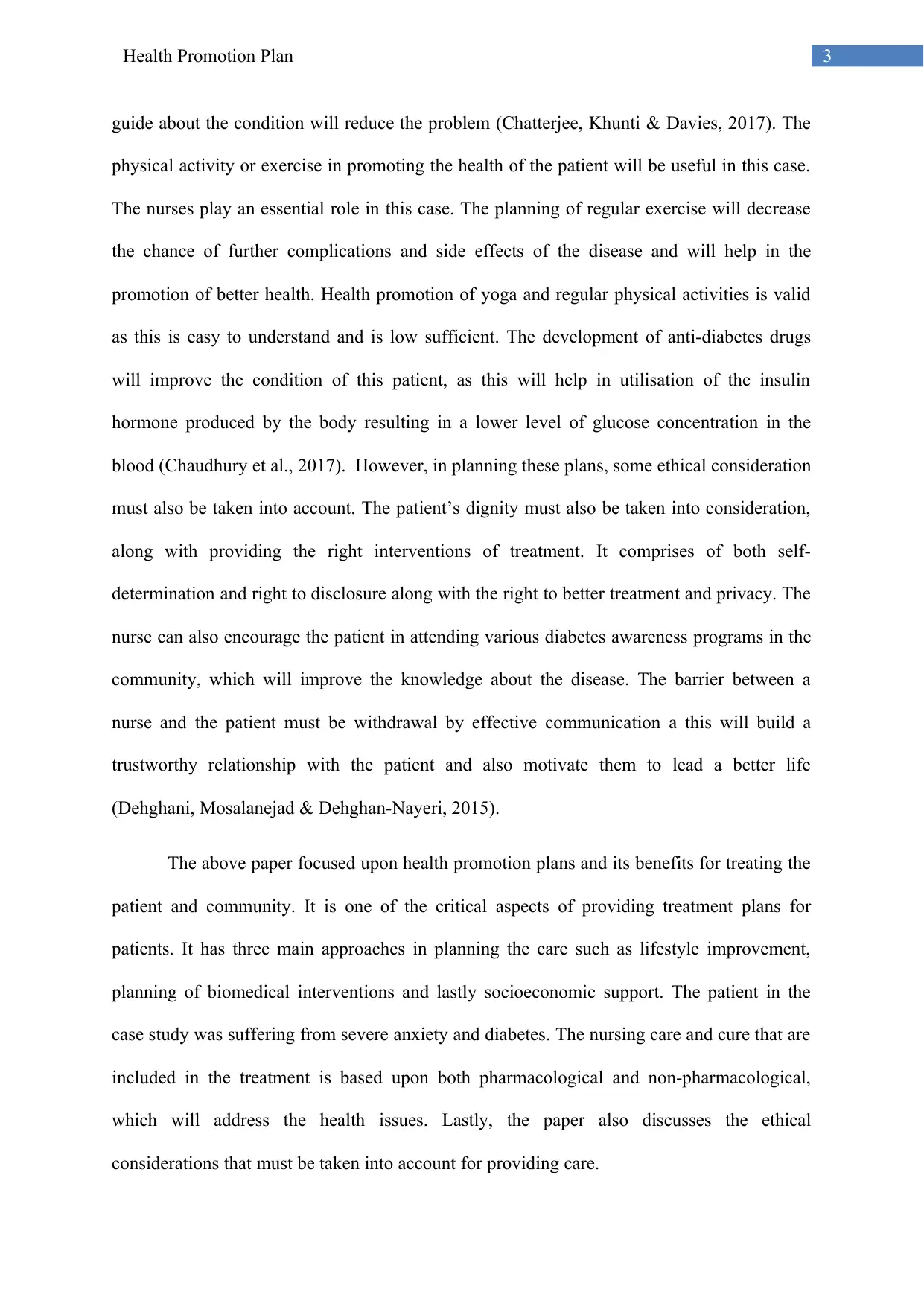
3Health Promotion Plan
guide about the condition will reduce the problem (Chatterjee, Khunti & Davies, 2017). The
physical activity or exercise in promoting the health of the patient will be useful in this case.
The nurses play an essential role in this case. The planning of regular exercise will decrease
the chance of further complications and side effects of the disease and will help in the
promotion of better health. Health promotion of yoga and regular physical activities is valid
as this is easy to understand and is low sufficient. The development of anti-diabetes drugs
will improve the condition of this patient, as this will help in utilisation of the insulin
hormone produced by the body resulting in a lower level of glucose concentration in the
blood (Chaudhury et al., 2017). However, in planning these plans, some ethical consideration
must also be taken into account. The patient’s dignity must also be taken into consideration,
along with providing the right interventions of treatment. It comprises of both self-
determination and right to disclosure along with the right to better treatment and privacy. The
nurse can also encourage the patient in attending various diabetes awareness programs in the
community, which will improve the knowledge about the disease. The barrier between a
nurse and the patient must be withdrawal by effective communication a this will build a
trustworthy relationship with the patient and also motivate them to lead a better life
(Dehghani, Mosalanejad & Dehghan-Nayeri, 2015).
The above paper focused upon health promotion plans and its benefits for treating the
patient and community. It is one of the critical aspects of providing treatment plans for
patients. It has three main approaches in planning the care such as lifestyle improvement,
planning of biomedical interventions and lastly socioeconomic support. The patient in the
case study was suffering from severe anxiety and diabetes. The nursing care and cure that are
included in the treatment is based upon both pharmacological and non-pharmacological,
which will address the health issues. Lastly, the paper also discusses the ethical
considerations that must be taken into account for providing care.
guide about the condition will reduce the problem (Chatterjee, Khunti & Davies, 2017). The
physical activity or exercise in promoting the health of the patient will be useful in this case.
The nurses play an essential role in this case. The planning of regular exercise will decrease
the chance of further complications and side effects of the disease and will help in the
promotion of better health. Health promotion of yoga and regular physical activities is valid
as this is easy to understand and is low sufficient. The development of anti-diabetes drugs
will improve the condition of this patient, as this will help in utilisation of the insulin
hormone produced by the body resulting in a lower level of glucose concentration in the
blood (Chaudhury et al., 2017). However, in planning these plans, some ethical consideration
must also be taken into account. The patient’s dignity must also be taken into consideration,
along with providing the right interventions of treatment. It comprises of both self-
determination and right to disclosure along with the right to better treatment and privacy. The
nurse can also encourage the patient in attending various diabetes awareness programs in the
community, which will improve the knowledge about the disease. The barrier between a
nurse and the patient must be withdrawal by effective communication a this will build a
trustworthy relationship with the patient and also motivate them to lead a better life
(Dehghani, Mosalanejad & Dehghan-Nayeri, 2015).
The above paper focused upon health promotion plans and its benefits for treating the
patient and community. It is one of the critical aspects of providing treatment plans for
patients. It has three main approaches in planning the care such as lifestyle improvement,
planning of biomedical interventions and lastly socioeconomic support. The patient in the
case study was suffering from severe anxiety and diabetes. The nursing care and cure that are
included in the treatment is based upon both pharmacological and non-pharmacological,
which will address the health issues. Lastly, the paper also discusses the ethical
considerations that must be taken into account for providing care.
Paraphrase This Document
Need a fresh take? Get an instant paraphrase of this document with our AI Paraphraser
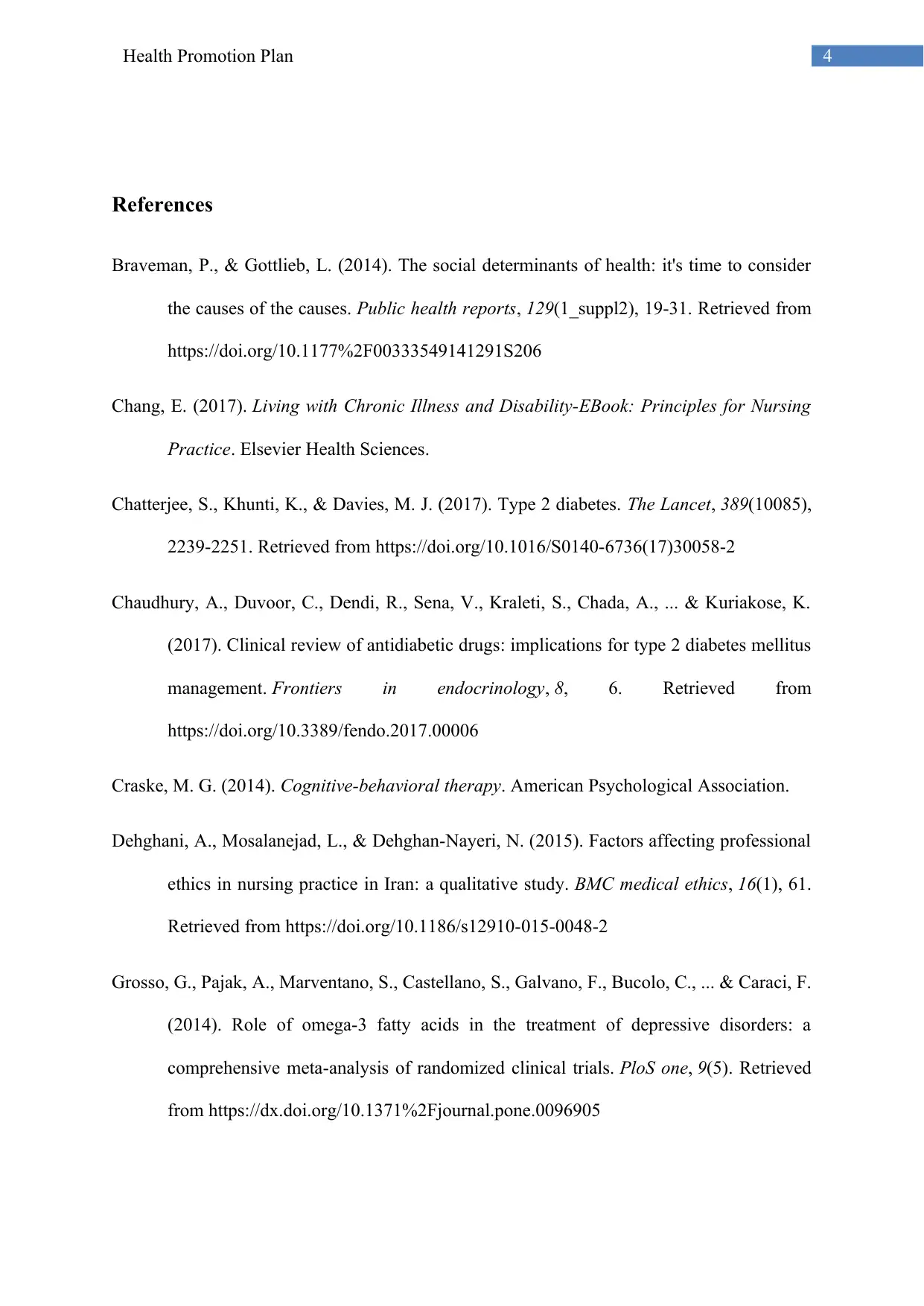
4Health Promotion Plan
References
Braveman, P., & Gottlieb, L. (2014). The social determinants of health: it's time to consider
the causes of the causes. Public health reports, 129(1_suppl2), 19-31. Retrieved from
https://doi.org/10.1177%2F00333549141291S206
Chang, E. (2017). Living with Chronic Illness and Disability-EBook: Principles for Nursing
Practice. Elsevier Health Sciences.
Chatterjee, S., Khunti, K., & Davies, M. J. (2017). Type 2 diabetes. The Lancet, 389(10085),
2239-2251. Retrieved from https://doi.org/10.1016/S0140-6736(17)30058-2
Chaudhury, A., Duvoor, C., Dendi, R., Sena, V., Kraleti, S., Chada, A., ... & Kuriakose, K.
(2017). Clinical review of antidiabetic drugs: implications for type 2 diabetes mellitus
management. Frontiers in endocrinology, 8, 6. Retrieved from
https://doi.org/10.3389/fendo.2017.00006
Craske, M. G. (2014). Cognitive-behavioral therapy. American Psychological Association.
Dehghani, A., Mosalanejad, L., & Dehghan-Nayeri, N. (2015). Factors affecting professional
ethics in nursing practice in Iran: a qualitative study. BMC medical ethics, 16(1), 61.
Retrieved from https://doi.org/10.1186/s12910-015-0048-2
Grosso, G., Pajak, A., Marventano, S., Castellano, S., Galvano, F., Bucolo, C., ... & Caraci, F.
(2014). Role of omega-3 fatty acids in the treatment of depressive disorders: a
comprehensive meta-analysis of randomized clinical trials. PloS one, 9(5). Retrieved
from https://dx.doi.org/10.1371%2Fjournal.pone.0096905
References
Braveman, P., & Gottlieb, L. (2014). The social determinants of health: it's time to consider
the causes of the causes. Public health reports, 129(1_suppl2), 19-31. Retrieved from
https://doi.org/10.1177%2F00333549141291S206
Chang, E. (2017). Living with Chronic Illness and Disability-EBook: Principles for Nursing
Practice. Elsevier Health Sciences.
Chatterjee, S., Khunti, K., & Davies, M. J. (2017). Type 2 diabetes. The Lancet, 389(10085),
2239-2251. Retrieved from https://doi.org/10.1016/S0140-6736(17)30058-2
Chaudhury, A., Duvoor, C., Dendi, R., Sena, V., Kraleti, S., Chada, A., ... & Kuriakose, K.
(2017). Clinical review of antidiabetic drugs: implications for type 2 diabetes mellitus
management. Frontiers in endocrinology, 8, 6. Retrieved from
https://doi.org/10.3389/fendo.2017.00006
Craske, M. G. (2014). Cognitive-behavioral therapy. American Psychological Association.
Dehghani, A., Mosalanejad, L., & Dehghan-Nayeri, N. (2015). Factors affecting professional
ethics in nursing practice in Iran: a qualitative study. BMC medical ethics, 16(1), 61.
Retrieved from https://doi.org/10.1186/s12910-015-0048-2
Grosso, G., Pajak, A., Marventano, S., Castellano, S., Galvano, F., Bucolo, C., ... & Caraci, F.
(2014). Role of omega-3 fatty acids in the treatment of depressive disorders: a
comprehensive meta-analysis of randomized clinical trials. PloS one, 9(5). Retrieved
from https://dx.doi.org/10.1371%2Fjournal.pone.0096905
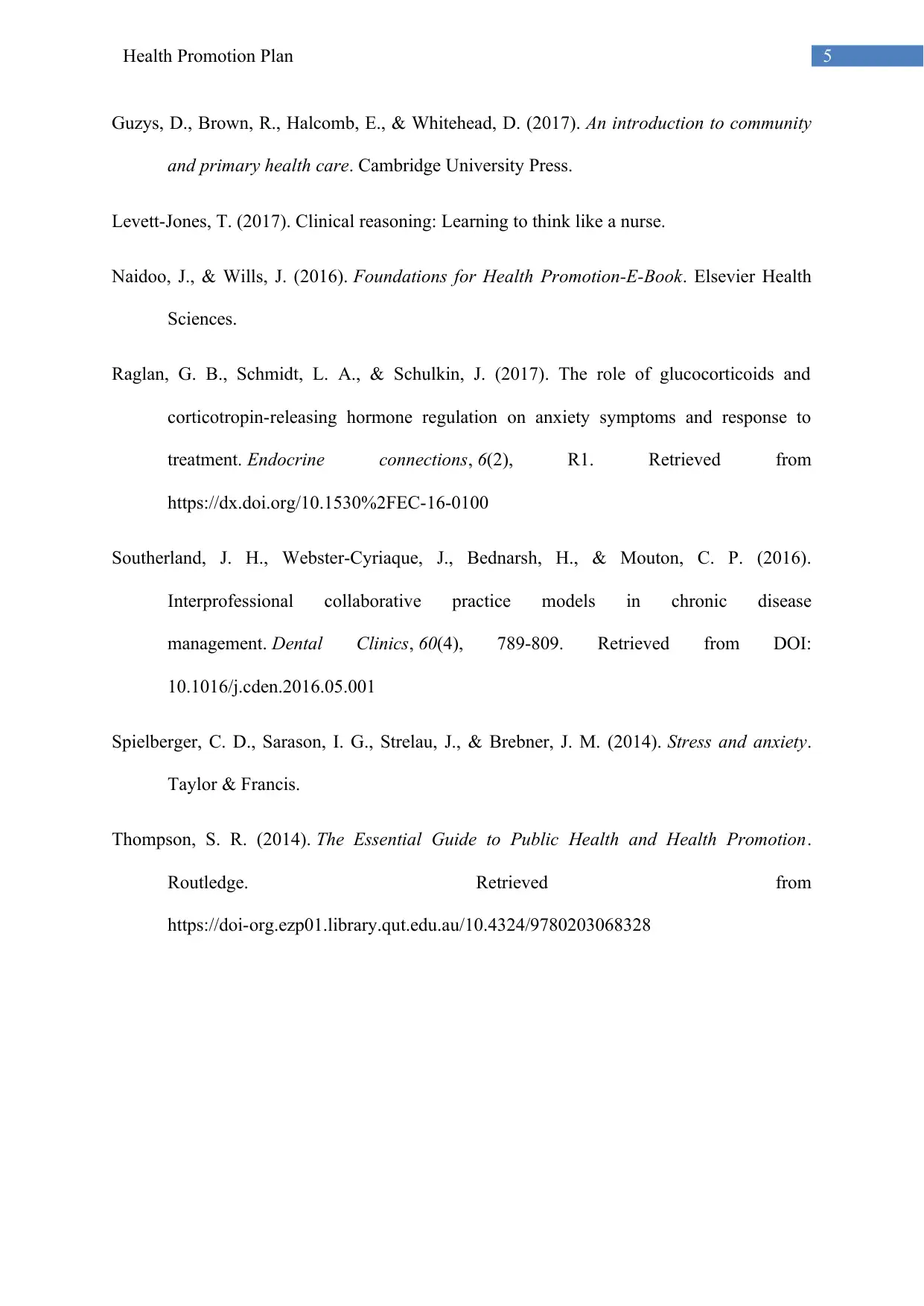
5Health Promotion Plan
Guzys, D., Brown, R., Halcomb, E., & Whitehead, D. (2017). An introduction to community
and primary health care. Cambridge University Press.
Levett-Jones, T. (2017). Clinical reasoning: Learning to think like a nurse.
Naidoo, J., & Wills, J. (2016). Foundations for Health Promotion-E-Book. Elsevier Health
Sciences.
Raglan, G. B., Schmidt, L. A., & Schulkin, J. (2017). The role of glucocorticoids and
corticotropin-releasing hormone regulation on anxiety symptoms and response to
treatment. Endocrine connections, 6(2), R1. Retrieved from
https://dx.doi.org/10.1530%2FEC-16-0100
Southerland, J. H., Webster-Cyriaque, J., Bednarsh, H., & Mouton, C. P. (2016).
Interprofessional collaborative practice models in chronic disease
management. Dental Clinics, 60(4), 789-809. Retrieved from DOI:
10.1016/j.cden.2016.05.001
Spielberger, C. D., Sarason, I. G., Strelau, J., & Brebner, J. M. (2014). Stress and anxiety.
Taylor & Francis.
Thompson, S. R. (2014). The Essential Guide to Public Health and Health Promotion.
Routledge. Retrieved from
https://doi-org.ezp01.library.qut.edu.au/10.4324/9780203068328
Guzys, D., Brown, R., Halcomb, E., & Whitehead, D. (2017). An introduction to community
and primary health care. Cambridge University Press.
Levett-Jones, T. (2017). Clinical reasoning: Learning to think like a nurse.
Naidoo, J., & Wills, J. (2016). Foundations for Health Promotion-E-Book. Elsevier Health
Sciences.
Raglan, G. B., Schmidt, L. A., & Schulkin, J. (2017). The role of glucocorticoids and
corticotropin-releasing hormone regulation on anxiety symptoms and response to
treatment. Endocrine connections, 6(2), R1. Retrieved from
https://dx.doi.org/10.1530%2FEC-16-0100
Southerland, J. H., Webster-Cyriaque, J., Bednarsh, H., & Mouton, C. P. (2016).
Interprofessional collaborative practice models in chronic disease
management. Dental Clinics, 60(4), 789-809. Retrieved from DOI:
10.1016/j.cden.2016.05.001
Spielberger, C. D., Sarason, I. G., Strelau, J., & Brebner, J. M. (2014). Stress and anxiety.
Taylor & Francis.
Thompson, S. R. (2014). The Essential Guide to Public Health and Health Promotion.
Routledge. Retrieved from
https://doi-org.ezp01.library.qut.edu.au/10.4324/9780203068328
⊘ This is a preview!⊘
Do you want full access?
Subscribe today to unlock all pages.

Trusted by 1+ million students worldwide
1 out of 6
Related Documents
Your All-in-One AI-Powered Toolkit for Academic Success.
+13062052269
info@desklib.com
Available 24*7 on WhatsApp / Email
![[object Object]](/_next/static/media/star-bottom.7253800d.svg)
Unlock your academic potential
Copyright © 2020–2025 A2Z Services. All Rights Reserved. Developed and managed by ZUCOL.





